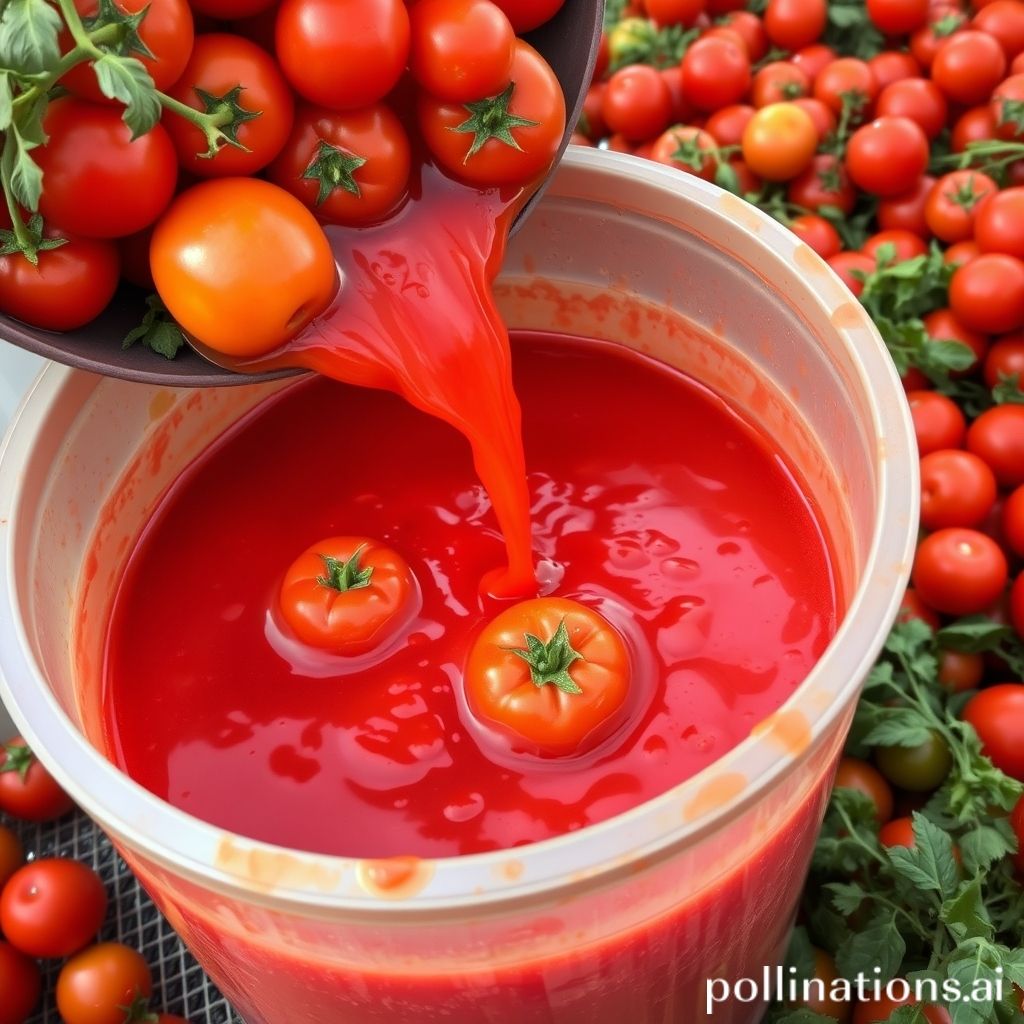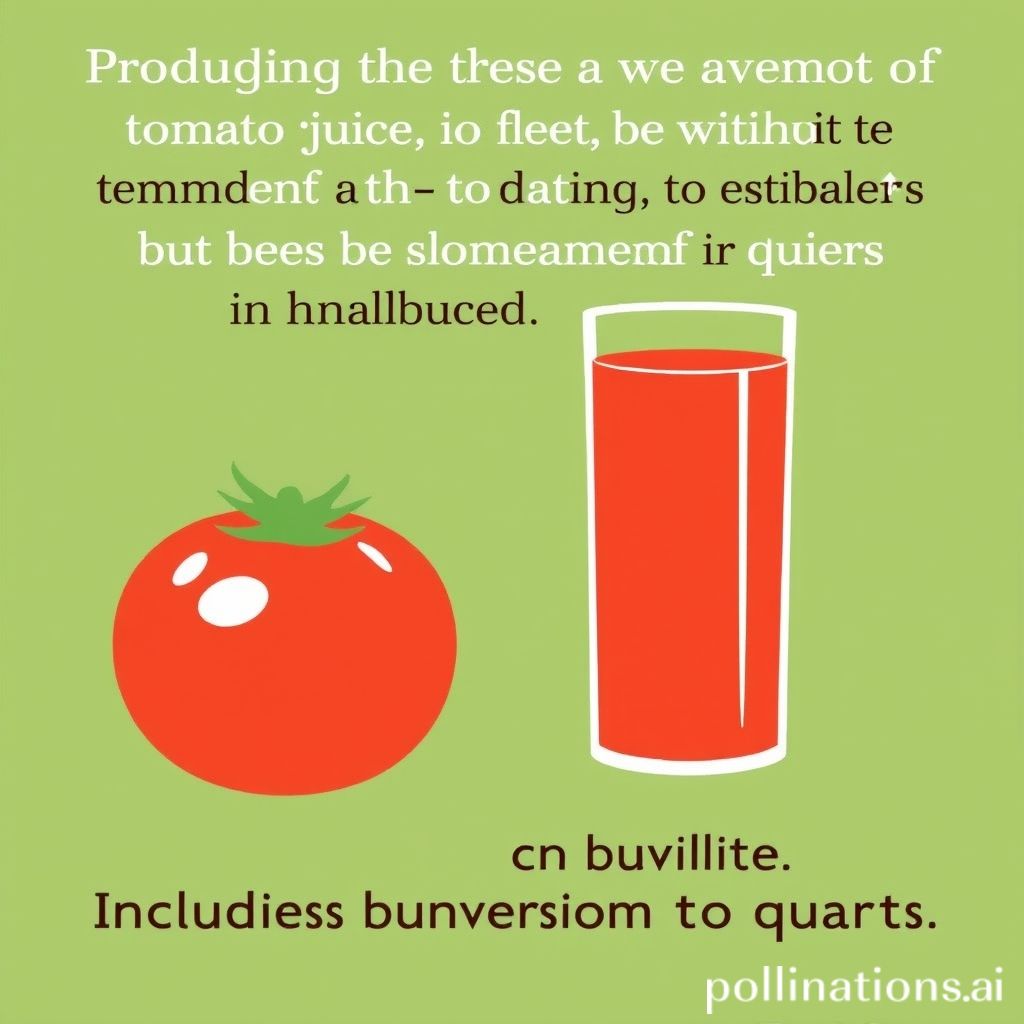How Many Quarts Of Tomato Juice In A Bushel?
How many quarts of tomato juice are in a bushel? In this comprehensive article, we delve deep into the world of tomato juice production, revealing the factors that impact yield, estimating the average juice output from a bushel, and sharing expert tips to maximize your tomato juice results.
Whether you’re a seasoned juicer or a beginner, this article equips you with the knowledge to make the most of your tomatoes. Get ready to savor the fruits of your labor and elevate your tomato juice game!

Table of Contents
Understanding Bushels and Tomato Juice Yield
Defining the Significance of a Bushel
A bushel is a unit of measurement commonly used in agriculture to quantify the volume of harvested crops. It plays a crucial role in determining the quantity of agricultural produce. Understanding the concept of a bushel is essential when calculating the yield of tomato juice.
Explaining the Tomato Juice Extraction Process
Extracting tomato juice from tomatoes involves several steps to ensure optimal flavor and quality. Here’s a breakdown of the process:
Harvesting Ripe Tomatoes
Ripe tomatoes are carefully picked from the vine to ensure maximum freshness and flavor. It is important to select tomatoes that are fully ripe but not overripe.
Washing and Sorting
The harvested tomatoes are thoroughly washed to remove any dirt or impurities. They are then sorted to separate damaged or unripe tomatoes from the ones suitable for juice extraction.
Blanching and Peeling
To facilitate the peeling process, the tomatoes are briefly blanched in boiling water. This helps loosen the skin, making it easier to remove. Once blanched, the tomatoes are immediately transferred to an ice bath to halt the cooking process.
Removing Seeds and Pulp
After peeling, the tomatoes are cut into halves or quarters, and the seeds and excess pulp are removed. This step ensures a smoother consistency for the final tomato juice.
Extracting the Juice
The prepared tomatoes are then processed using a juicer or a food mill to extract the juice. This step separates the liquid from the remaining solids, resulting in pure tomato juice.
Straining and Bottling
To achieve a smooth and clear juice, the extracted tomato juice is strained through a fine-mesh sieve or cheesecloth. It is then ready for bottling or canning, depending on personal preference and storage requirements.
By understanding the significance of a bushel and the process of extracting tomato juice from tomatoes, you can accurately determine the yield of tomato juice in quarts per bushel. This knowledge is valuable for both commercial producers and home gardeners seeking to make the most of their tomato harvest.
Expert Tip: Maximize tomato juice yield by selecting ripe tomatoes, blanching and peeling them, and using a juicer or food mill for extraction.Factors Affecting Tomato Juice Yield
1. Tomato Variety
Different tomato varieties can have varying juice yields. Some varieties, such as Roma or San Marzano tomatoes, are known for their high juice content and are ideal for juicing purposes.
2. Ripeness of Tomatoes
The ripeness of tomatoes plays a significant role in juice yield. Fully ripe tomatoes tend to have more juice compared to under-ripe ones. It is important to use fully ripe tomatoes when juicing to maximize the juice yield. However, overripe tomatoes may have a softer texture and could affect the quality of the juice.
3. Juicing Method
The method used to extract juice from tomatoes can also impact the yield. There are various juicing methods available, including using a juicer, blender, or manual extraction. Each method may yield different results in terms of juice quantity. Some methods might be more efficient in extracting juice, while others may result in a lower yield.
To provide a comprehensive overview, the following table summarizes the factors affecting tomato juice yield:
| Factors | Impact on Juice Yield |
|---|---|
| Tomato Variety | Different varieties have varying juice yields. Choose varieties known for high juice content. |
| Ripeness of Tomatoes | Fully ripe tomatoes yield more juice compared to under-ripe ones. |
| Juicing Method | The method used to extract juice can affect the quantity of juice obtained. |
By considering these factors, you can optimize your tomato juice yield and ensure a delicious and refreshing outcome. Select the right tomato variety, use fully ripe tomatoes, and choose an appropriate juicing method to make the most out of your bushel of tomatoes.
Average Yield of Tomato Juice from a Bushel
Estimating the Average Amount of Tomato Juice
When determining the average yield of tomato juice from a bushel of tomatoes, several factors come into play, including tomato size, variety, and juicing method. On average, a bushel of tomatoes can yield approximately 8 to 12 quarts of tomato juice.
Understanding Bushels and Quarts
Before discussing the average yield, it’s important to understand the conversion between bushels and quarts. A bushel is a unit of volume commonly used to measure agricultural produce, including tomatoes. On the other hand, a quart is a unit of volume equivalent to a quarter of a gallon or two pints.
Factors Affecting Tomato Juice Yield
The amount of tomato juice obtained from a bushel can vary based on several factors:
- Tomato Variety: Different tomato varieties have varying levels of juiciness, affecting the yield.
- Ripeness: Ripe tomatoes generally yield more juice compared to underripe ones.
- Preparation Method: The method used to prepare the tomatoes for juicing, such as blanching or pureeing, can impact the yield.
- Juicing Technique: The juicing technique employed, whether using a manual juicer, electric juicer, or blender, can also affect the amount of juice extracted.
Tips for Maximizing Tomato Juice Yield
To obtain the maximum amount of tomato juice from a bushel of tomatoes, consider the following tips:
- Choose Juicy Varieties: Opt for tomato varieties known for their juiciness, such as Beefsteak or Roma tomatoes.
- Use Ripe Tomatoes: Select fully ripe tomatoes as they tend to yield more juice.
- Proper Preparation: Properly blanch, peel, and core the tomatoes before juicing to maximize the yield.
- Efficient Juicing: Utilize an efficient juicing technique and equipment to extract the maximum amount of juice.
By considering these factors and following the provided tips, you can estimate and maximize the amount of tomato juice obtained from a bushel of tomatoes. Enjoy the delicious taste of homemade tomato juice!

Tips for Maximizing Tomato Juice Yield
Selecting the Right Tomato Variety
Choosing the appropriate tomato variety is crucial for maximizing tomato juice yield. Look for varieties known for their high juice content and flavor, such as Roma tomatoes, San Marzano tomatoes, and Amish Paste tomatoes.
Using Fully Ripe Tomatoes
For optimal flavor and juice extraction, use fully ripe tomatoes. Ripe tomatoes are deep red in color, slightly soft to the touch, and have a higher sugar content, resulting in sweeter and more flavorful juice. Avoid using underripe or overripe tomatoes.
Optimal Juicing Techniques
The juicing technique employed can significantly impact the yield of tomato juice. Here are some tips to maximize juice extraction:
- Remove the seeds: Cut the tomatoes in half and gently squeeze out the seeds to avoid a bitter taste.
- Use a food mill or strainer: Pass the tomato pulp through a food mill or strainer to separate the juice from the skin and remaining solids, achieving a smoother consistency.
- Apply gentle pressure: When extracting the juice, apply gentle pressure to avoid including any bitter compounds from the seeds or skin.
| Information |
|---|
| Tomato juice yield can vary depending on the tomato variety, ripeness, and juicing techniques used. By selecting the right tomato variety, using fully ripe tomatoes, and employing optimal juicing techniques, you can maximize your tomato juice yield and enjoy a flavorful and refreshing beverage. |
Other Uses for Tomatoes in Addition to Juice
Tomato Sauce
Tomato sauce is a versatile and delicious way to use tomatoes. It is a base for Italian dishes like pasta, pizza, and lasagna. You can enhance tomato sauce with herbs and spices to add depth and tanginess to your dishes.
Salsa
Salsa is a popular condiment that adds flavor to Mexican and Tex-Mex cuisine. It usually contains tomatoes, onions, peppers, cilantro, lime juice, and seasonings. Salsa can be mild or spicy and goes well with tacos, quesadillas, and grilled meats.
Tomato Paste
Tomato paste is a concentrated form of tomatoes that adds richness to dishes. It is made by cooking tomatoes for a long time and reducing them to a thick paste. Tomato paste is commonly used in soups, stews, sauces, and marinades.
These alternative uses provide a range of flavorful options in addition to juicing tomatoes. Whether you make tomato sauce, salsa, or use tomato paste, you can enjoy the versatility and deliciousness of tomatoes in various dishes. Try different recipes and savor the natural goodness of this versatile fruit.
Conclusion
This blog post has provided valuable information on the quantity of tomato juice in a bushel. By understanding the factors that can affect tomato juice yield and employing optimal juicing techniques, individuals can maximize the amount of juice obtained. It is important to choose the right tomato variety and use fully ripe tomatoes for the best results.
Additionally, alternative uses for tomatoes, such as tomato sauce and salsa, were highlighted. By considering these factors and tips, individuals can make the most of their bushel of tomatoes and enjoy the delicious taste of homemade tomato juice.
Faq about Tomato Juice
FAQ 1: How many pounds are in a bushel of tomatoes?
A bushel of tomatoes weighs approximately 53 pounds.
FAQ 2: Can I use unripe tomatoes for juicing?
Yes, unripe tomatoes can be used for juicing. However, their flavor may not be as rich or sweet as ripe tomatoes.
FAQ 3: How long does homemade tomato juice last?
Homemade tomato juice can last for 5-7 days when stored in a tightly sealed container in the refrigerator.
FAQ 4: Can I freeze tomato juice?
Yes, tomato juice can be frozen. It is recommended to pour the juice into freezer-safe containers, leaving room for expansion, and store it in the freezer for up to 6 months.
FAQ 5: What are popular tomato varieties for juicing?
Popular tomato varieties for juicing include Roma tomatoes, Beefsteak tomatoes, and San Marzano tomatoes. These varieties are known for their rich flavor and high juice content, making them ideal for juicing purposes.

